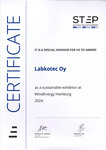News Release from Schaeffler Technologies AG & Co. KG
Wind Industry Profile of
70 years old but with an entire future ahead: The cage-guided needle roller bearing from Schaeffler
70 years ago, Dr.-Ing. E.h. Georg Schaeffler revolutionized bearing technology. The idea: To improve guidance of the needles in the needle roller bearing by using a cage. The first practical tests involving cage-guided needle roller bearings began in February 1950. The results were convincing – the components exhibited extremely low wear and friction. The application for a patent in September 1950 laid the foundation for the product's success. In February 1951, just one year after construction of the first prototype, the first volume production orders were obtained from automotive manufacturers, and use in industrial applications was to follow. “With this invention, my father, Georg Schaeffler, laid the foundation for the rapid growth of our company. The cage-guided needle roller bearing is one of the most important innovations in our company's history as an automotive and industrial supplier,” says Georg F. W. Schaeffler, Family Shareholder and Chairman of the Supervisory Board. “The development of this very product is, in itself, an impressive example of what sets us apart: We have utilized all synergies in the cage-guided needle roller bearing, which will allow us to serve all relevant target markets with this innovative product and generate real customer benefits – in both the automotive and the industrial sector.”
Higher speeds with less friction
With the invention Dr.-Ing. E.h. Georg Schaeffler eliminated the serious disadvantages associated with the full complement needle roller bearings that had previously been used as standard: The long needle rollers tended to move in a transverse direction during rotation of the bearing (skewing), which would then cause the bearing to jam. Furthermore, a substantial amount of sliding friction was generated between the counter-rotating needle rollers. The development of the new needle cage overcame these disadvantages and permitted considerably higher speeds and less friction. This allowed engineers to substitute other bearing designs for cage-guided needle roller bearings and significantly improve the performance of their applications.
In particular, needle roller bearings made an invaluable contribution to the development of small, high-performance, and affordable automobiles. “Without reliable needle roller bearings, modern automotive drives would still be inconceivable today,” says Matthias Zink, CEO Automotive Technologies at Schaeffler. The use of needle roller bearings in mechanical and plant engineering, construction and agricultural machinery, and in conveyor technology, was also being gradually introduced.
Role in future markets
Needle roller bearings will continue to play a key role in the future. In e-mobility, needle roller bearings are vital for the function of numerous electrified transmissions. Needle roller and cage assemblies facilitate bearing arrangements with a minimal design envelope, since their section height only corresponds to the diameter of the needle rollers. In addition, they have a high load carrying capacity and are inexpensive compared with other bearing designs. KZK needle roller bearings (crank pin cages) are used, for example, in e-axles with a coaxial design. One application example is the Schaeffler e-axle drive, which has been produced for the Audi e-tron since 2018.
In industry too, where lightweight robots are increasingly in demand, the use of needle bearings permits light and compact joint designs by means of downsizing. The needle bearings provide minimal variability and the highest level of safety. The most recent example is the angular contact needle roller bearing XZU from Schaeffler, which is used both as an articulated arm bearing in lightweight robots and cobots, and as the main bearing arrangement in the new RTWH precision gearbox, a ready-to-install reduction gear unit for robot joints.
Technological development
What originally started life as an ingenious idea by Dr.-Ing. E.h. Georg Schaeffler, has been continuously developed by Schaeffler engineers over the course of 70 years, both in terms of performance and the variety of available types. Compared to a machined needle roller bearing from the 1950s, the operating life for bearings with the same dimensions has increased fifteenfold, and the static load carrying capacity has tripled. The power density, which has been enormously improved thanks to the needle roller and cage assembly, offers considerable downsizing potential for applications that are easier on energy and resources.
There has also been a steady increase in the variety of types: Today, the Schaeffler needle roller bearing portfolio comprises more than 15,000 variants to fulfill a wide variety of requirements. Since the patent application was filed 70 years ago, Schaeffler has sold a total of more than 100 billion needle roller bearings. The length of the wires used in the production of 60 billion needle roller bearings annually would be sufficient to wind around the earth's equator 18 times. Almost 170 million needle rollers are produced from this wire every day.
- Source:
- Schaeffler AG
- Author:
- Press Office
- Link:
- www.schaeffler.de/...
- Keywords:
- Schaeffler, cage-guided, needle roller bearing, bearing, technology, market, robotics, automotive, supplier, friction, speed



























